Cor!! Buster Easter Special 2020: Buster & Delbert, the team-up you’ve been waiting for!
8th April 2020
Get ready for laughter with the return of the Cor!! Buster Easter Special 2020, where the Treasury of British Comics brings you a very special special for the second year running. In these very difficult times, we could all do with a giggle, a guffaw, the odd chuckle, or just the chance to plain old laugh our socks off!
Buy now in print and digital >>
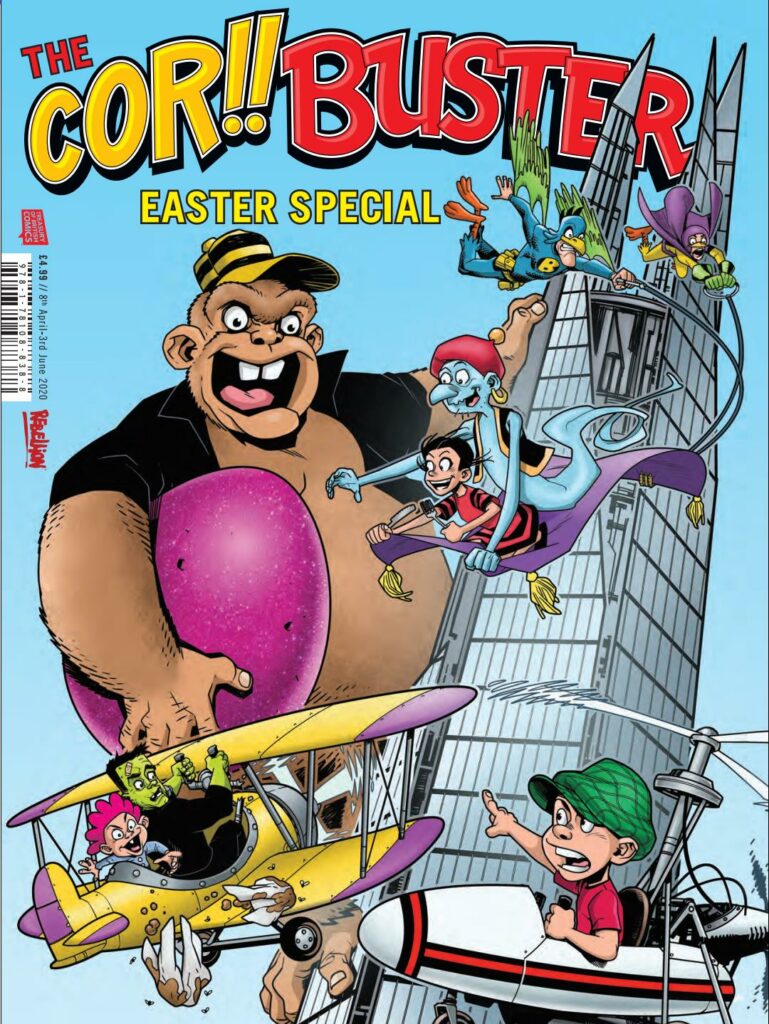
And opening the Special list year, just as they did last year, it’s writer John Freeman and artist Lew Stringer to give us another egg-citing adventure featuring a true gaggle of famous (and obscure) characters from the past of Brit humour comics in Buster & Delbert!
The Cor!! Buster Easter Special 2020 goes on sale Wednesday 8th April 2020 from all good newsagents, whatever comic shops may still be open (please support them however you can!), and through the 2000 AD and Treasury of British Comics web shops.
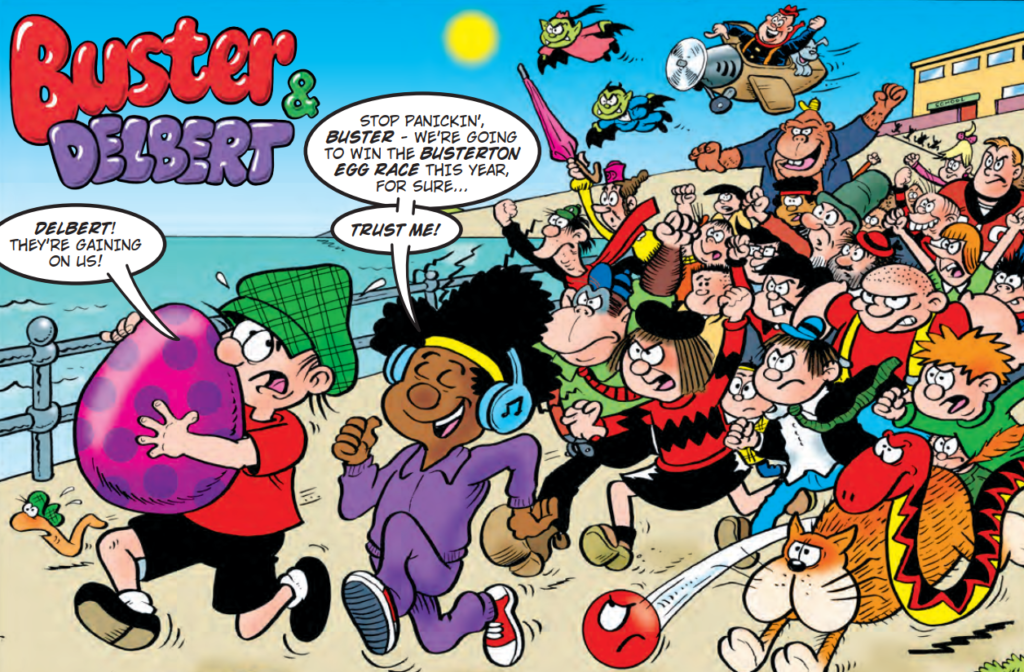
John, Lew, last year, you gave us Who’s In Charge?, featuring comics’ greatest editorial team-up of all time. This year, you’re both involved again with Buster & Delbert.
Now, I’d guess most people will be at least familiar with Buster, but fewer will know who Delbert is. So, first of all, could you fill us in on just who these two main characters are?
John Freeman: Lew can expand on this, but Delbert is a member of Buster’s gang, a group of kids who all feature in this story. Being incredibly ancient, my memories of Buster stretch back to the 1960s and 70s, but editor Keith Richardson is a sprightly young thing in comparison – and rightly pointed me toward 1990s Buster last year as a source of characters he rightly felt more potential readers would remember.
I dug out later copies of Buster from a box and plundered the local secondhand shops for copies and came across some hugely inventive stories, and quickly got to grips with the dynamics of Buster’s “gang”, I hope. I even found a map of the park the Buster gang run through in one issue!
Buster was in the comic from the start back in May 1960, drawn by the brilliant Bill Titcombe, who is still with us I believe, although I haven’t spoken to him for a while, and was originally sold to comic readers as the son of the Daily Mirror’s Andy Capp, which I gather Capp’s creator, Reg Smythe, positively hated. Buster is only mentioned once in the newspaper strip, I believe, although Andy does cameo briefly in a couple of Buster strips. The character had some great artists working on the strip down the years, including a personal favourite, Reg Parlett, Tom Paterson and Jimmy Hansen.
Lew Stringer: Buster originated in 1960 when he headlined BUSTER, the first of Fleetway’s new style comics that was offering something different to the old Comic Cuts style of weekly that had become tired and old fashioned. It was the new age of cheeky kid characters (instigated by The Beano in the 1950s) although Buster was more of a lovable rogue than a menace like Dennis!
Delbert joined the strip much later, around the late 1980s, when editors decided to give Buster a gang, rather than the stories being just about him. There hadn’t been many black characters in humour comics until then, unless shown in a horribly derogatory racist way, so hopefully, the readers appreciated Delbert being Buster’s best pal.
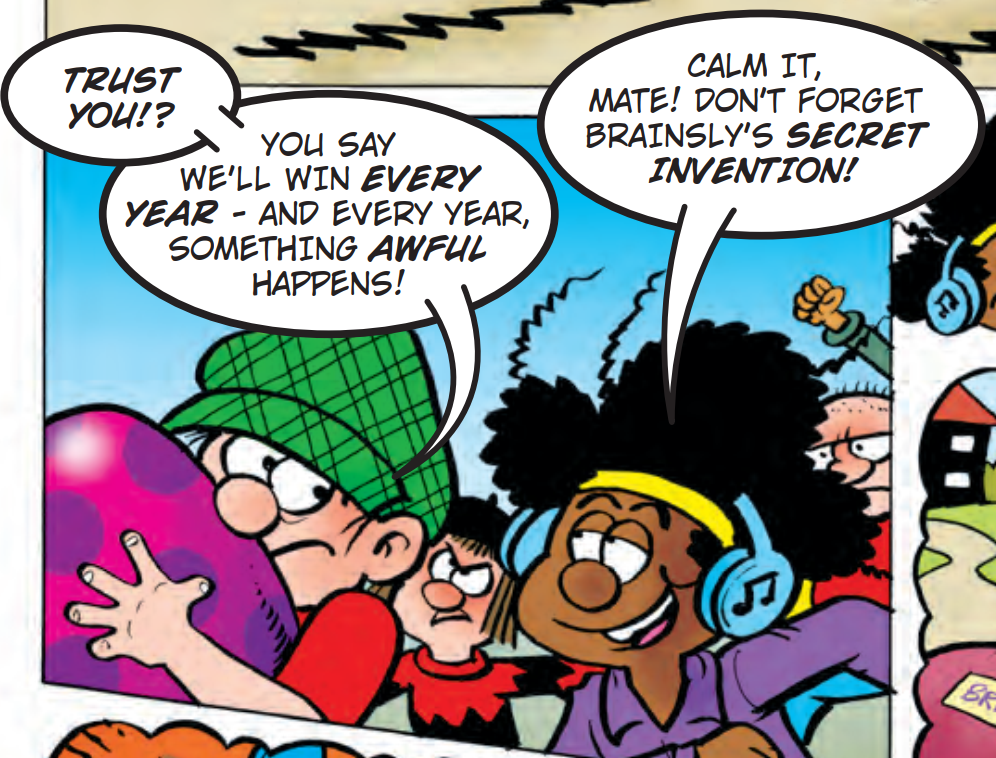
So, what’s the story in Buster & Delbert all about?
JF: Hopefully, we’ve managed to write a strip that older fans will love, new fans will enjoy without needing to know nearly 60 years of back story, and pick up a couple of gags from last year’s Special!
LS: It’s a busy, fast-paced script from John featuring Easter eggs, chase scenes, crowds of funny characters, and a slap-up feed. All the elements of a traditional UK humour strip!
JF: Editor Keith Richardson gave us an Easter theme brief. I grew up in St. Ives in Cornwall, where they have an annual ‘Feast Day’ that celebrates the anniversary of the consecration of the Parish Church of St Eia in 1434, and offers a rare chance to watch the game of Hurling the Silver Ball, a centuries’ old form of rugby.
So bearing in mind the Easter theme of the Special this year, after a pitching a number of ideas we have Buster and Delbert in an Egg Race – and hoping to keep the ceremonial egg until the end of the race, by fair means or foul (geddit?). Lew literally ran with it, adding all sorts of wonderful characters as cameos in the background from decades of humour comics.
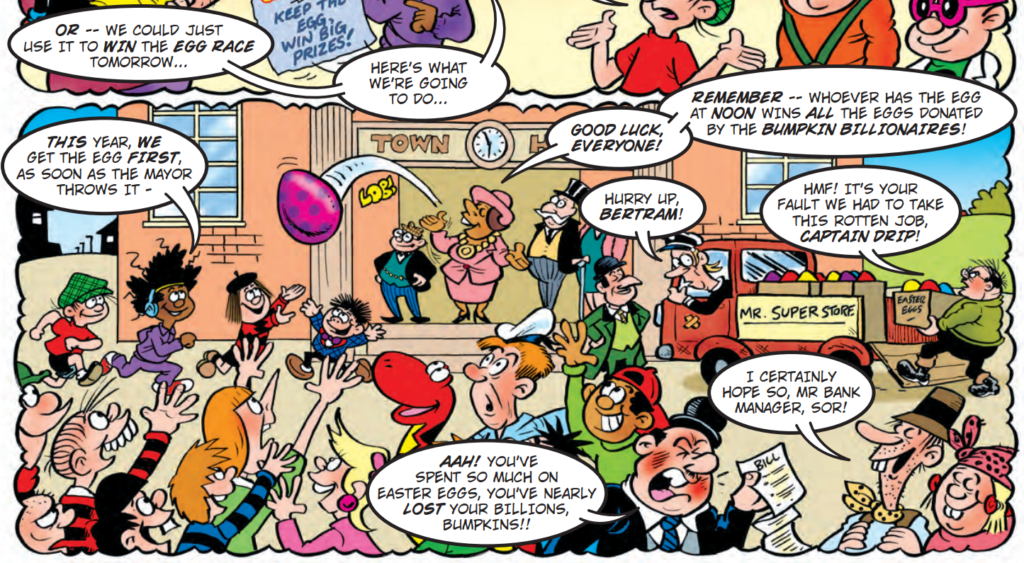
It’s a real who’s who of some fabulous characters, with many familiar faces and quite a few not so familiar.
Was it a case of getting together and deciding who was going to be in the strip, or was it more Lew dropping the characters into the background?
JF: Absolutely not as regards many of the background characters, although I did of course come up with the crew of Ken Reid’s Queen of the Seas relegated to hapless delivery drivers, using the Bumpkin Billionaires, and Shake (from Shiver and Shake) makes a cameo in his new guise as a Dragon’s Den-styled entrepreneurial elephant.
Lew has an incredible, encyclopaedic knowledge of British comic humour characters – he should be writing a book while we’re bogged down with this flippin’ Coronavirus Pandemic – and added in some fantastic cameos. I’m sure he can tell you who they all are, he even had some uber fans scratching their heads with some of them when Rebellion released a preview page!
LS: John suggested some who are in there (such as the ones who have dialogue of course) but it was mostly left to me. I’m a big fan of the 1960s comics and earlier so I thought I’d put in some characters from Wham! and Smash! Along with some even more obscure ones like Alfie the Air Tramp from the 1930s.
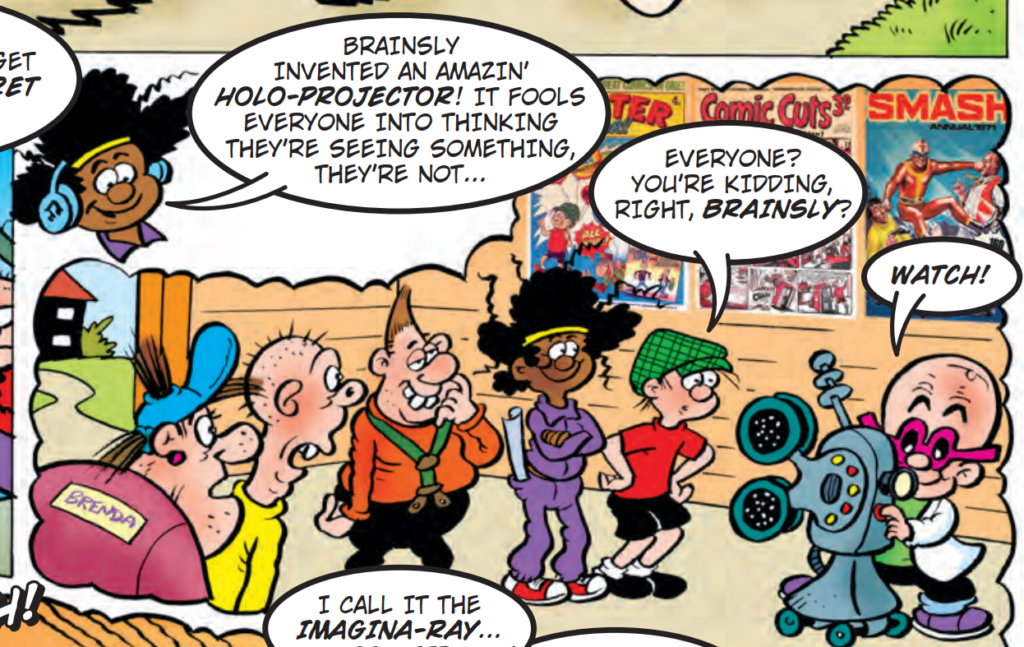
Hopefully, we’ll see more of these kids specials coming from the Treasury of British Comics. And thinking ahead, what other characters would you love to get your hands on in the future from the massive archive at the Treasury of British Comics.
LS: Having drawn various ones in the crowd scenes this time I’d like to tackle some of the Smash! characters such as Bad Penny or Wiz War. I like drawing the vintage characters such as Weary Willie and Tired Tim, but they’re too outdated to return in anything but a cameo. Then again, I’ve worked on some 1930s characters for D.C. Thomson (Keyhole Kate, Big Eggo, and Julius Sneezer) so who knows?
JF: It’s been a privilege to have had the chance to play with just some of Rebellion’s classic characters and I really hope sales success will lead to an increased frequency of these Specials, even a more regular humour title. Obviously they were good enough last year to get this Special greenlit, but let’s put the Pandemic in its place and make them even better this year, eh?
If there’s ever a regular humour comic from Rebellion, I’d love to write a new Mowser, the mangy cat strip who first appeared in Lion. You can’t go wrong with cats in comics in my book!
There are a number of adventure characters I have a soft spot for, too – Steel Claw and Adam Eterno among them.
As we talked about last year, it’s a great thing to see the Cor! & Buster Special out there, bringing these classics to (hopefully) new readers as well as those readers picking it up with nostalgic memories.
Have you had any feedback from people indicating that we’ve seen new readers picking the comic up?
LS: Yes, I’ve heard from people who have said how much their kids enjoyed it. Hopefully, it appeals to all ages.
JF: From what I can gather, sales of last year’s Special were good, which is what all involved hoped.
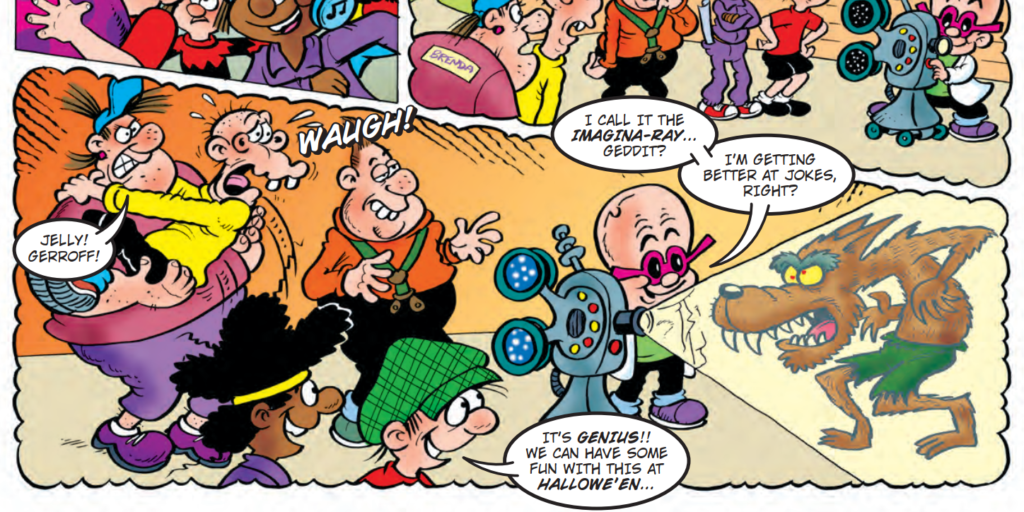
We’ve also seen Rebellion open up the kids market with the hugely sucessful Regened issues of 2000 AD.
But, it’s also possible to find dissenting voices, those who complain that these new versions of what they remember simply aren’t as good. And it’s more often than not a case of refusing to acknowledge that the comics of their youth, the things they loved, may not be quite right for an audience of very media-savvy kids.
JF: I think the comments made by fans of the original comics are sometimes interesting, but as Lew has pointed out, many times, comics have always evolved and moved on. The Dennis the Menace of the 1950s is nothing like the Dennis and Gnasher of Beano and CBBC, but he’s still hugely popular. I can see the same being done with classic Rebellion characters and welcome it.
You simply don’t sit still as a creator or publisher, you innovate, experiment, build on your audience. In the case of humour comics, the staple part of that audience is not fifty to sixty-year-olds who remember it first time around. Rebellion have released far more archive collections than any other British comics publisher and have had considerable success with Roy of the Rovers with a fantastic updating of the character and setting, and all power to them for doing that.
LS: Yes, some forget that everyone’s “golden age” is just a few years of their childhood and their disinterest in kids comics is simply because they’ve grown out of them! Today’s kids still love comics, when they can find them! I meet a lot of families at conventions (or did, before we shifted into this nightmare parallel world) and the kids are just as enthusiastic about today’s comics as we were at their age about the classics.
Absolutely Lew, there’s certainly an appetite for kids comics. You can see that around the world with such authors as Raina Telgemeier and Dav Pilkey selling their graphic novels in the millions year after year. Kids want to read comics, that’s a definite.
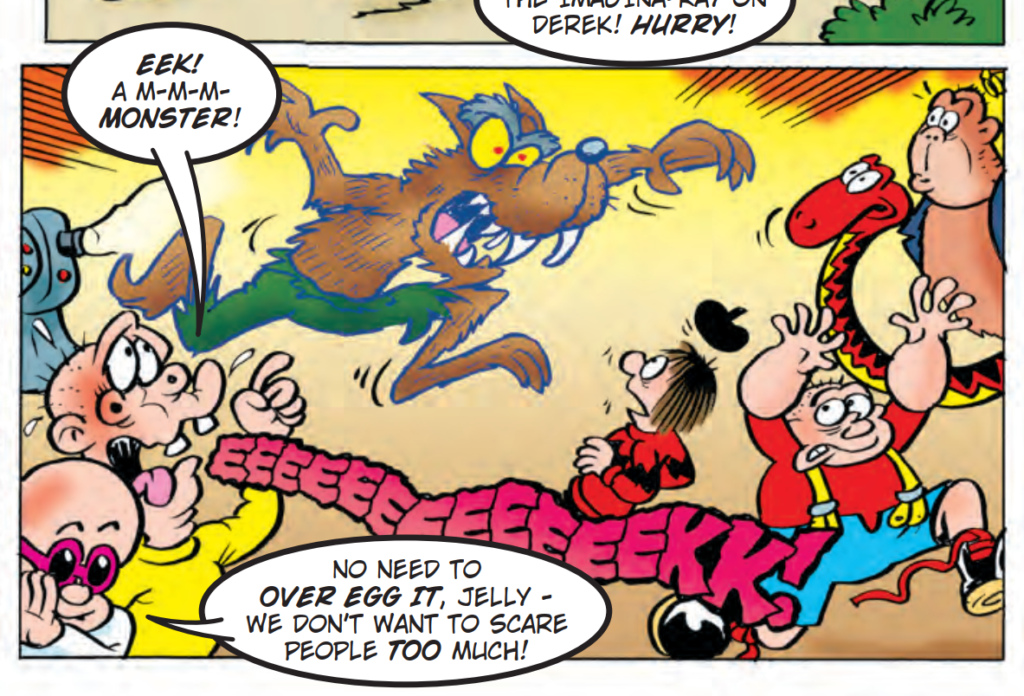
So, what would you like to see happening with both the Treasury of British Comics reprint collections and these new re-workings of classic characters in the Cor!! Buster Special?
LS: What I’d like to see and what may happen are two different things. A new weekly is not going to happen but I’d like to see Buster (or another humour title) return on some sort of regular basis. Perhaps monthly, or more realistically, as a seasonal quarterly special. Depending how the publishing industry gets through the current pandemic, it might be that books are more likely, in the way that the thrice-a-year Roy of the Rovers albums are working. I just hope that we see something!
JF: A regular humour comic, even if only quarterly at first, and a new adventure comic, too. Rebellion should build out from a subscription base on these projects, just like The Phoenix Comic has done, because the newsstand simply isn’t new launch friendly any longer, unless you already have a brand those “media savvy” kids recognise.
I’m patient. I’ve got my Trigan Empire. Projects like David Roach’s Masters of British Comics have helped stir all those nostalgia cells in my ageing brain. I laughed out loud at Alec Worley and Hilary Barta’s Kid Kong in this year’s Special. We’re in a good place right now in terms of the amount of classic material we’re being treated to, far more than we have for years. I’m an optimist, but the sales evidence is there to show that optimism is not misplaced. Exciting times are ahead, no matter what this bug throws at us. Let’s go!
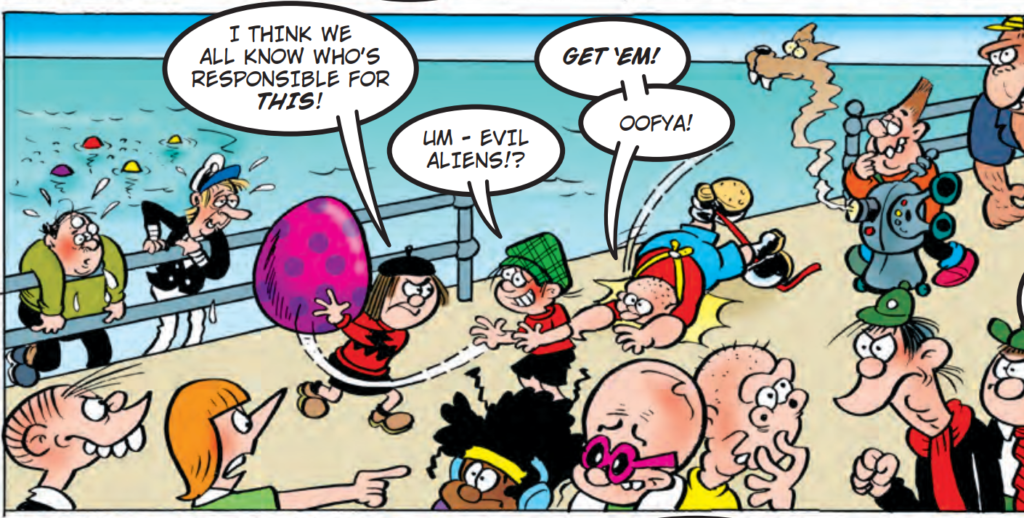
Now, we’ll end with a simple one… What do you think is the way forward for kids comics?
JF: Obviously, with any creative enterprise, there will be some missteps, and not everyone is going to like everything that is being published, but the ongoing success of 2000AD, Beano and The Phoenix shows it is possible to make a success of the newsstand with some determination and ingenuity, for all the barriers in place courtesy and retailer idiosyncrasies and awkwardness.
Look at sales of Beano – they’ve come back from the brink and are around 48,000 a week, on average, with a huge element of subscriptions in that figure that was almost zero a few years ago. There’s still demand for comics; comic creators aplenty will tell you how much schoolchildren enjoy creating them when they do workshops, for example. Comics are hugely important for reluctant readers, too. Those that say comics aren’t for “media savvy” kids are, in my book, simply wrong.
Obviously, we don’t yet know how the Coronavirus Pandemic is going to play out and the impact it may have on the retailer environment. Worryingly, we do know that there will be comic shops that sadly will not survive this, unless their customers stay loyal and return to them. Goodness only knows what will happen to WHSmith. But local corner shops are benefitting from what’s happening, and hopefully will be even keener to offer a larger range of comics and magazines in future, when in recent years they have been stymied from ordering them for their customers by some distributors, which is utterly bonkers; and perhaps supermarkets will expand their range, although some already carry a huge range of titles.
Rebellion has been building its 2000AD brand in general, and the Treasury of British Comics, and it’s amazing just what a footprint they have achieved with, I assume, a small but dedicated marketing team and a budget in comparison with, for example, game companies, who in normal times don’t think twice about writing a cheque for £20,000 to boost the coffers of an event, seeing it as small change in the building of brand.
Comics publishing, like other forms of publishing, is a commercial enterprise. You pitch to the biggest potential audience. That is not a few fans in relatively small social media groups, simply because the algorithms of those platforms appear to give them a louder voice. You have to have your own vision; by all means listen and appreciate, but make your own creative choices based on facts and figures not misinformed conjecture.
If comics weren’t a vibrant, powerful medium, which has expanded massively over the past twenty years in terms of reach and audience, why are there so many comics projects on Kickstarter? Why are so many determined creative teams publishing their own independent comics anthologies and stories? Because comics are still relevant, that’s why – for all of us.
Well, you did ask!
